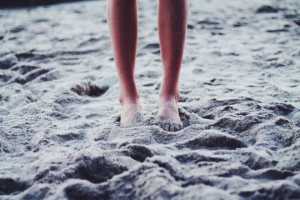In this world there is no certainty except death, taxes, and gravity.
Gravity exerts downward force on our bodies, all the time. Perhaps the most noticeable effect is the compression of the spine. With compression over time, the moisture and sponginess of the intervertebral discs (sponge-like discs stacked between each of the vertebrae in our spine) is lost – the spine shortens, the posture starts to droop and sag. In your asana practice, you’ve probably noticed gravity’s ceaseless efforts to acquaint your face to the floor in bakasana, or its clinging on to your leg in half-moon pose like a petulant child holding on to his mother.
Sounds bleak, but all is not lost. Newton’s Third Law states that every action has an equal and opposite reaction. Simply put, when you push down, you go up. Whatever is in contact with the floor, press down and use the rebound forces to lift every inch of the body – rather than sinking into the floor, weighed down and compressed.
The feet are particularly interesting – they are the one body part entirely concerned with informing and regulating the relationship between the earth and the rest of the body. We generally only think of one arch in the foot, the most obvious medial arch which runs along the instep of the foot. But we actually have 2 other arches, the transverse arch in the ball of the foot, and the lateral arch from little toe to heel.
When standing upright, downward forces, ie. the whole weight of the body, travel through 3 main points in contact with the floor: the base of the big toe, base of the little toe, and the heel. The arches direct energy upwards from these points, so that the support from the earth rebounds through. By consciously rooting or pressing down through the 3 main points, you’re activating the arches, sending a lift through the legs.
The only thing left to do is to channel that lift upwards. What we’re looking for is a plumb line through the major vertical axis running up the standing leg: the sitting bones directly over the heel bones, the upper torso directly over the pelvis. This vertical positioning maximizes structural support, meaning your muscles work more efficiently and you don’t feel like you’re battling against gravity to keep your spine elongated, supple and healthy.
If you’re serious about feeling grounded and finding steadiness and stillness in postures, don’t miss Suzi Vavrikova’s Going Deeper with Yin Yoga workshop, one Sunday a month – check website for upcoming dates! Next one Sun 24 Apr, 4-6pm, book HERE.
Photo credit: LoveThisPic
